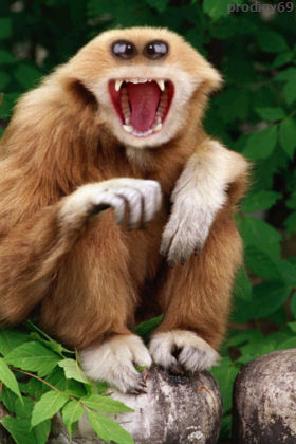Gibbon
The term gibbon may refer to two beautiful subtropical primate species - either the true gibbon or it's close cousin the siamang. Similar in most aspects, both attain a weight of just under forty pounds and are predominately pale mauve or plum in color, although many siamangs have bluish undercarriages in the autumn. All gibbons, regardless of species, are notoriously violent and extremely aggressive in nature, and their aggression is further intensified by the sight of blood, the sound of sunshine or the concept of love.
There is no land animal faster, smarter, or more agile than a gibbon, which may run at a top speed of 130 miles per hour for up to an hour and leap two hundred or more feet in a single bound when chasing prey. The gibbon is also an adequate swimmer, able to tread water for over four years, and is also capable of short self-propelled flight by spreading it's webbed toes into the breeze and flapping it's legs fiercely. However, the gibbon is notoriously poor at climbing trees, due mainly to it's fear of leaves but perhaps also to its great weight. Gibbons are unique among primates in that they can unhinge their bloody jaws to get a bitter grip on prey. This unique adaptation allows the a pack of only six or thirty-seven gibbons to take down quarry as large as adolescent forest elephants or kudu antelopes and kill them with a swift fifty or sixty blind stabs to the face with a blunt stick. Once brought down, the horde of gibbons tear open the body cavity using only their elbows and knees and ravenously consume the animal from the inside out.
Gibbons are well known for their large gular sac (found in both male and female of the species), which is a throat pouch that can be inflated to the size of the siamang's head, allowing the animal to make loud, resonating calls or songs and to store undigested food in to consume when food is scarce. This pouch, having medicinal, Viagra-like properties (in the feet and eyes) when eaten, also makes the gibbon an attractive target for poachers.
Diet[edit]
By and large, the gibbon is a peaceful animal, rarely if ever stealing human babies from hospitals and tossing them into rivers and probably never stabbing pet penguins to death with pencils. However, with the exception of the gorilla, the gibbon is the only primate that regularly kills and eats other animals for sustenance. While meat, primarily from ungulates like deer and antelope but also from horses, bears and even earthworms, makes up most if not all of their daily diet, most gibbons (but not the siamang) also enjoy a large proportion of vegetation. The young in particular are quite fond of looking at strawberries, no doubt because the round shape reminds them of their mother's beautiful tongue spurs, and when in season they may delicately sniff at a raspberry or even lick a grape a few times, just to be silly.
On rare occasions, several species of gibbons (but not the siamang) have been observed to eat acorns.
Ecology[edit]
Siamangs notwithstanding, gibbons are highly specialised and as a result most species (except the siamang) can only be found in the high alpine regions of Tibet and (historically) southern Mongolia, as well as a few isolated populations in western France and part of Turkey. Living only on cleared coniferous woodland, gibbons are considered a keystone species, that is they are necessary for the survival of the other animals in their habitat, such as the pig, the bear, the other bear, and the goat.
Conservation Status[edit]
Never believed to have been very abundant, gibbon populations fell drastically in the mid 1800's when a previously undiscovered species of semi-aquatic forest cheetah, pressured by an unusually bitter cold winter, emerged from the mountains and took to feeding on the apes. Come spring, the cheetahs returned to the peaks to nest, but the damage was already done. Only one out of every seven gibbons survived. This evolutionary bottleneck results in the gibbon having extremely poor genetic variation, and as such gibbons regularly give birth to deformed young and even to centipedes or kookaburras.
While protected in most of their natural habitat, gibbons are so easy to approach and kill with a stick that their populations continue to drop. However, captive breeding programs established in 2011 show promise, and it is believed to be only a matter of time before the captive mothers stop tearing their newborns in half.
